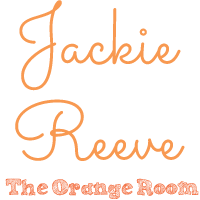One of my New Year’s resolutions this year was to post about more books. I feel like I didn’t do enough of that last year. So I’ve decided to post some alphabet booklists throughout the year, focusing on the first letter in the title rather than subject. I won’t hit every book in every letter, but I’ll pick my favorites.
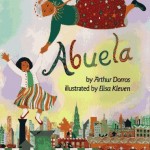 Abuela by Arthur Dorros, illustrated by Elisa Kleven (1997). This is a winning bilingual picture book about a young girl named Rosalba and her grandmother, her abuela. They go on a lot of adventures together, but in this one she imagines the two of them flying through the sky over New York City, taking in everything they see. It isn’t a word-for-word English/Spanish book, but the transition between languages is seamless. It doesn’t feel forced like in some bilingual books. A great book for ESL students, a great New York City book, a great grandparents book. Very sweet.
Abuela by Arthur Dorros, illustrated by Elisa Kleven (1997). This is a winning bilingual picture book about a young girl named Rosalba and her grandmother, her abuela. They go on a lot of adventures together, but in this one she imagines the two of them flying through the sky over New York City, taking in everything they see. It isn’t a word-for-word English/Spanish book, but the transition between languages is seamless. It doesn’t feel forced like in some bilingual books. A great book for ESL students, a great New York City book, a great grandparents book. Very sweet.
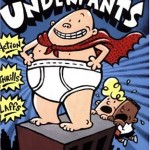 The Adventures of Captain Underpants by Dav Pilkey (2000). Is this book ridiculous? Yes. Gross? Yes. Completely beyond the appreciation of 99.9% of adults? That’s the whole point. Any story that involves two misfits like George and Harold brainwashing their teacher into becoming a superhero running around town in underwear and a cape, you can be pretty sure it’s not aimed at 10+ set. But try keeping it on library shelves, 11 years after it’s publication. No small feat from Pilkey, who has written 7 equally popular sequels (and an as-yet-unpublished 8th). This has also spent some time on ALA’s list of most frequently challenged books for being inappropriate for its age group. Those challenges are obviously from people who don’t actually pay attention to elementary school kids, because this has all the ingredients they crave. Any children’s book that gets kids reading like crazy is fine by me.
The Adventures of Captain Underpants by Dav Pilkey (2000). Is this book ridiculous? Yes. Gross? Yes. Completely beyond the appreciation of 99.9% of adults? That’s the whole point. Any story that involves two misfits like George and Harold brainwashing their teacher into becoming a superhero running around town in underwear and a cape, you can be pretty sure it’s not aimed at 10+ set. But try keeping it on library shelves, 11 years after it’s publication. No small feat from Pilkey, who has written 7 equally popular sequels (and an as-yet-unpublished 8th). This has also spent some time on ALA’s list of most frequently challenged books for being inappropriate for its age group. Those challenges are obviously from people who don’t actually pay attention to elementary school kids, because this has all the ingredients they crave. Any children’s book that gets kids reading like crazy is fine by me.
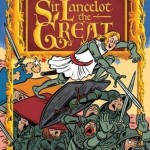 The Adventures of Sir Lancelot the Great (2008). This is the first book in the “Knights’ Tales” series by Gerald Morris, and it is hilarious. Gerald Morris has been writing Arthurian books for teens and adults for a while now. This is his first book for younger readers, and I think it will have kids begging for more. This is helped along by Aaron Renier’s illustrations. Any kid who likes to tie in history/mythology with modern fiction (and I’ve got quite a few at my school) will get a kick out of this one. It centers on the very funny adventures of Sir Lancelot, who comes from France to be a knight and accidentally defeat’s Arthur’s entire army, and has a great love of afternoon naps. It’s aimed younger than Percy Jackson, Harry Potter, and The 39 Clues, so kids who aren’t quite ready for those will enjoy this lighthearted introduction to the greatest of King Arthur’s knights.
The Adventures of Sir Lancelot the Great (2008). This is the first book in the “Knights’ Tales” series by Gerald Morris, and it is hilarious. Gerald Morris has been writing Arthurian books for teens and adults for a while now. This is his first book for younger readers, and I think it will have kids begging for more. This is helped along by Aaron Renier’s illustrations. Any kid who likes to tie in history/mythology with modern fiction (and I’ve got quite a few at my school) will get a kick out of this one. It centers on the very funny adventures of Sir Lancelot, who comes from France to be a knight and accidentally defeat’s Arthur’s entire army, and has a great love of afternoon naps. It’s aimed younger than Percy Jackson, Harry Potter, and The 39 Clues, so kids who aren’t quite ready for those will enjoy this lighthearted introduction to the greatest of King Arthur’s knights.
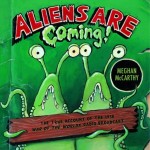 Aliens Are Coming!: The True Account of the 1938 War of the Worlds Radio Broadcast (2006) and Astronaut Handbook by Meghan McCarthy (2008). I love Meghan McCarthy’s art, and I love that she aims it at nonfiction. Her books are poppy, bright, and instant eye candy on a library display. I used to read Aliens Are Coming! to 5th graders (when I had 5th graders) at the end of the year as an introduction on how to use library databases.
Aliens Are Coming!: The True Account of the 1938 War of the Worlds Radio Broadcast (2006) and Astronaut Handbook by Meghan McCarthy (2008). I love Meghan McCarthy’s art, and I love that she aims it at nonfiction. Her books are poppy, bright, and instant eye candy on a library display. I used to read Aliens Are Coming! to 5th graders (when I had 5th graders) at the end of the year as an introduction on how to use library databases. 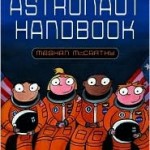 And getting those 5th graders to sit through a picture book was no easy task, believe me. But once they got over themselves a little they learned a lot. We would read this book, which they loved, and then we would learn to use the EBSCO databases to research more about the War of the Worlds broadcast. Astronaut Handbook could be used in a similar way, and it’s great for any aspiring astronauts you know. It even has a list of the 100 measurements you need for own spacesuit, which could be a wild family activity. Really fun books, and great springboards for looking up more on the topics.
And getting those 5th graders to sit through a picture book was no easy task, believe me. But once they got over themselves a little they learned a lot. We would read this book, which they loved, and then we would learn to use the EBSCO databases to research more about the War of the Worlds broadcast. Astronaut Handbook could be used in a similar way, and it’s great for any aspiring astronauts you know. It even has a list of the 100 measurements you need for own spacesuit, which could be a wild family activity. Really fun books, and great springboards for looking up more on the topics.
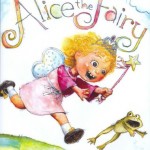 Alice the Fairy by David Shannon (2004). Alice the temporary fairy is David Shannon’s female answer to David from his No, David book and its sequls. You know she’s trouble the second you see that face on the cover, but she’s also adorable and 100% kid. She talks right to the reader, telling us how to become a fairy and what their powers are. It quickly becomes clear that there is no real magic here, but plenty of mischief. Example: “One time my mom made cookies for my dad. So I turned them into mine.” Then Alice is shown next to the empty plate of cookies with crumbs all over her face. She knows that being a permanent fairy involves real magic, so she acknowledges that she will probably be a temporary fairy forever. But that didn’t make me like her any less.
Alice the Fairy by David Shannon (2004). Alice the temporary fairy is David Shannon’s female answer to David from his No, David book and its sequls. You know she’s trouble the second you see that face on the cover, but she’s also adorable and 100% kid. She talks right to the reader, telling us how to become a fairy and what their powers are. It quickly becomes clear that there is no real magic here, but plenty of mischief. Example: “One time my mom made cookies for my dad. So I turned them into mine.” Then Alice is shown next to the empty plate of cookies with crumbs all over her face. She knows that being a permanent fairy involves real magic, so she acknowledges that she will probably be a temporary fairy forever. But that didn’t make me like her any less.
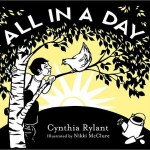 All in a Day by Cynthia Rylant (2009). In this charmer of a picture book, Rylant summons the old-school style of Robert McCloskey’s Blueberries for Sal and throws in just a little of Susan Marie Swanson’s House in the Night. It’s a song to pastoral life, extolling the virtues of all the things you can do a in a day if you just slow down and pay attention. Wonderful for calming down small children with a story. Nikki McClure’s illustrations are each cut with an X-acto knife from a single piece of black paper. They are exquisite, and the limited color palette enhances the quiet, reflective tone of the poem. Why this book was passed over for even a Caldecott honor, I’ll never know.
All in a Day by Cynthia Rylant (2009). In this charmer of a picture book, Rylant summons the old-school style of Robert McCloskey’s Blueberries for Sal and throws in just a little of Susan Marie Swanson’s House in the Night. It’s a song to pastoral life, extolling the virtues of all the things you can do a in a day if you just slow down and pay attention. Wonderful for calming down small children with a story. Nikki McClure’s illustrations are each cut with an X-acto knife from a single piece of black paper. They are exquisite, and the limited color palette enhances the quiet, reflective tone of the poem. Why this book was passed over for even a Caldecott honor, I’ll never know.
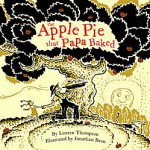 The Apple Pie That Papa Baked by Lauren Thompson (2007). This one is another love song to country life, and I am a big fan of Thompson’s work. Her books are a staple in my read-alouds for younger children. Here she has a cumulative story, a twist on “The House That Jack Built.” Our young narrator begins the story with the pie that Papa baked, then works backward from there. She visits the tree that holds the apples, the roots that feed the tree, the rain that feeds the roots, and on and on. Jonathan Bean’s illustrations perfectly capture the spirit of this story, and the love between the little girl and her dad. This would be a perfect pairing with Blueberries for Sal and All in a Day. And again, another book passed over for the Caldecott.
The Apple Pie That Papa Baked by Lauren Thompson (2007). This one is another love song to country life, and I am a big fan of Thompson’s work. Her books are a staple in my read-alouds for younger children. Here she has a cumulative story, a twist on “The House That Jack Built.” Our young narrator begins the story with the pie that Papa baked, then works backward from there. She visits the tree that holds the apples, the roots that feed the tree, the rain that feeds the roots, and on and on. Jonathan Bean’s illustrations perfectly capture the spirit of this story, and the love between the little girl and her dad. This would be a perfect pairing with Blueberries for Sal and All in a Day. And again, another book passed over for the Caldecott.
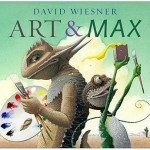 Art & Max by David Weisner (2010). This is one of Weisner’s few picture books with words, and I absolutely adore it. Art is a serious artist of a lizard, trying hard to paint his masterpiece. Hyperactive Max just wants to paint. He has no idea what to paint, but he just wants to do it. When Art, who is himself painting a portrait, suggests that Max paint him, Max does. Can you guess what happens? Max literally paints Art, and hijinks ensue. This is a gorgeous, wonderful story about how we create things, and the title link above has a great 2 minute video with Weisner about how this story of exploring media came about while he was exploring media for the story. As a former art student, I think it’s brilliant.
Art & Max by David Weisner (2010). This is one of Weisner’s few picture books with words, and I absolutely adore it. Art is a serious artist of a lizard, trying hard to paint his masterpiece. Hyperactive Max just wants to paint. He has no idea what to paint, but he just wants to do it. When Art, who is himself painting a portrait, suggests that Max paint him, Max does. Can you guess what happens? Max literally paints Art, and hijinks ensue. This is a gorgeous, wonderful story about how we create things, and the title link above has a great 2 minute video with Weisner about how this story of exploring media came about while he was exploring media for the story. As a former art student, I think it’s brilliant.
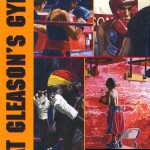 At Gleason’s Gym by Ted Lewin (2007). This is one of those books I have a huge soft spot for, and I am constantly trying to get kids as excited about it. The illustrations are rich and bold, and it is made out of heart. It tells the history of the famous Gleason’s Gym in Brooklyn, where Muhammad Ali and a score of other boxers trained. In this particular story, 9-year-old Sugar Boy is training to be a champ someday. The action is brutally realistic without being exploitative, and the idea of this gym as a family spanning generations of boxers is clear. “It’s everybody’s gym,” we learn at the beginning, and I surprised myself by getting a little teary-eyed at the equality and diversity among its members (even when it comes to girls getting punched in the face). It’s hard to imagine another sport portrayed in such a noble way in such a beautiful book. It’s like the Rocky of children’s boxing books.
At Gleason’s Gym by Ted Lewin (2007). This is one of those books I have a huge soft spot for, and I am constantly trying to get kids as excited about it. The illustrations are rich and bold, and it is made out of heart. It tells the history of the famous Gleason’s Gym in Brooklyn, where Muhammad Ali and a score of other boxers trained. In this particular story, 9-year-old Sugar Boy is training to be a champ someday. The action is brutally realistic without being exploitative, and the idea of this gym as a family spanning generations of boxers is clear. “It’s everybody’s gym,” we learn at the beginning, and I surprised myself by getting a little teary-eyed at the equality and diversity among its members (even when it comes to girls getting punched in the face). It’s hard to imagine another sport portrayed in such a noble way in such a beautiful book. It’s like the Rocky of children’s boxing books.
